What is general information about the backcourt in basketball
General definition and reference to court location
The backcourt comprises one half of the full court on the side that is opposite where the current offensive team would attempt to score points in the appropriate basket.
The diagrams below attempt to demonstrate this concept.
Also, for the following diagrams, each offensive player is typically indicated by a number that represents a standard basketball position and each defensive player has a correlated number to a similar position that is shown alongside the letter X.
Essentially, 1 is the offensive point guard while X1 is the defensive point guard.
2 is the offensive shooting guard while X2 is the defensive shooting guard.
3 is the offensive small forward while X3 is the defensive small forward.
4 is the offensive power forward while X4 is the defensive power forward.
Finally, 5 is the offensive center while X5 is the defensive center.
Example of offensive team on the opposite side of their backcourt
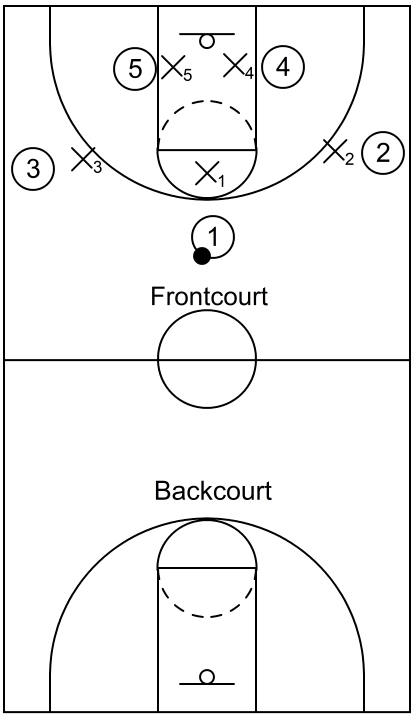
On the diagram, the offensive team is currently located on the side of the court that is opposite of their backcourt, which is also known as their frontcourt.
Furthermore, the offensive team is currently set up in a 3 out 2 in formation while the opposing team implements man to man defense.
From there, 1, who has possession of the basketball, represented by the black dot, could execute their team’s basketball offense strategy in an attempt to score points in the basket on that same side of the court.
Conversely, the defensive team could attempt to prevent their opponent from scoring points with various basketball defense tactics of their own.
Example of offensive players initially in their backcourt moving into the opposite side
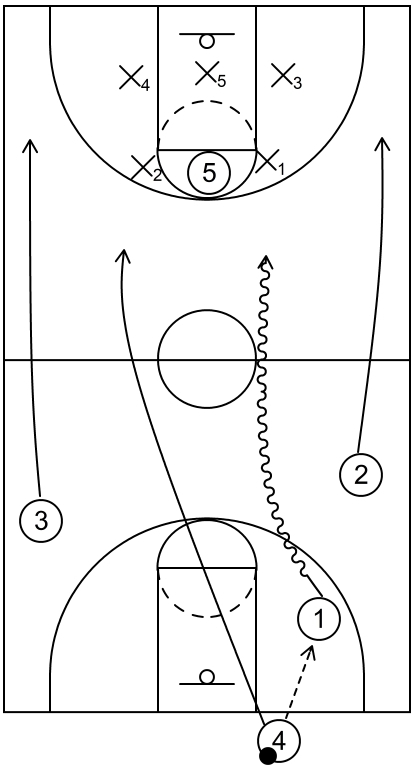
For this example diagram, certain members of the offensive team will move from their backcourt into the opposite side, which again, is also known as the frontcourt.
Essentially, 1 receives the ball from 4 via an inbound pass denoted by the dotted arrow and afterwards, 1 dribbles toward the frontcourt, represented by the arrow with the wavy line.
Moreover, as that takes place, 2, 3, and 4 sprint into the frontcourt from the backcourt respectively.
Also, it should be noted for this example that the defensive team has already set up on the opposite side of the offensive team’s backcourt and have initiated a 2-3 zone defense strategy.
Furthermore, 5 had already moved into the side opposite the backcourt as well and established position near the high post area between X1 and X2.
Example of defense to offense transition opportunity from the backcourt area – Part 1
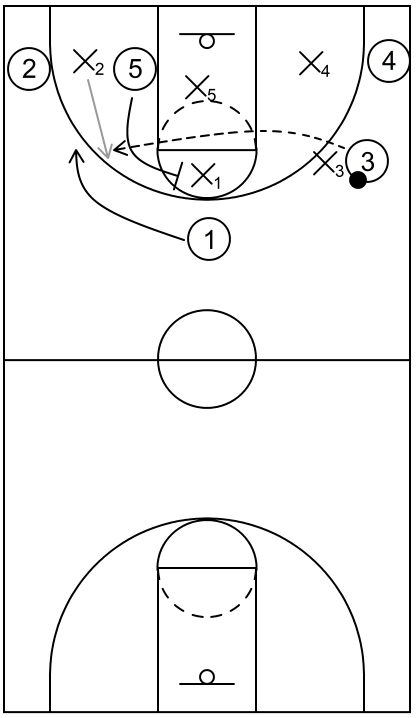
This is an example of basketball action that features a defender gaining possession of the ball by stealing it from the opposing team, which then triggers a transition opportunity from the current backcourt area.
To begin, the offensive team is in their frontcourt and 3 initially has possession of the ball near the right side wing while being guarded by X3.
Following that, 1 cuts toward the left side wing area via a flare screen set by 5.
However, as that happens, X2 is able to read the play and subsequently step into the passing lane to steal the ball via interception, indicated by the gray arrow.
This leads to a turnover for the former offensive team as well as a transition opportunity for X2 and teammates who would then be the new offensive team.
Example of defense to offense transition opportunity from the backcourt area – Part 2
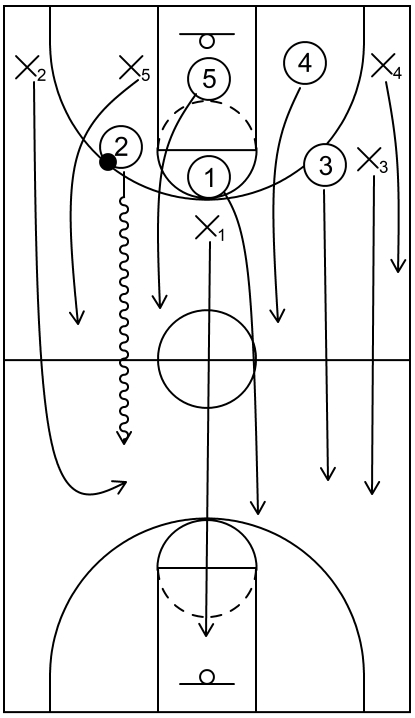
At this point, 2, who was previously X2, has possession of the basketball while in their team’s backcourt, which was also the former frontcourt of the opposing team.
From there, 2 can begin to dribble the ball into their team’s frontcourt while attempting to score points via transition offense.
Moreover, as the fast break action happens, the other current offensive players who would be 1, 3, 4, and 5 can sprint from their team’s backcourt into the frontcourt as well to create potential passing and/or scoring options for 2.
At the same time, the former offensive players who are now the current defensive players, X1 through X5 should also sprint into the offensive team’s frontcourt (which is also the defensive team’s backcourt) to hinder or prevent easy scoring opportunities, most notably, layups or dunks at the rim.
General definition and reference to basketball positions
In terms of basketball positions, the point guard and shooting guard are sometimes referred to as the backcourt.
Offensively, those particular players would typically advance the ball by dribbling it or passing it from their own backcourt area to their frontcourt area.
The basic diagram below attempts to showcase the backcourt positions as well as the backcourt area for the current offensive team.
Example of backcourt positions and backcourt area
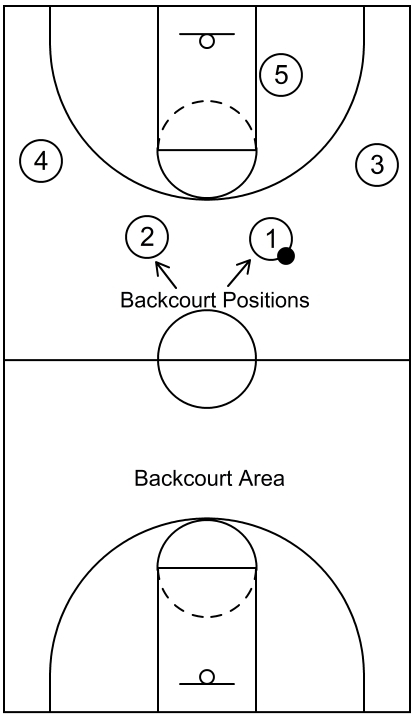
On the diagram above, 1 and 2 are located in the slot areas near the top of the basketball court.
The other non-backcourt (or frontcourt) positions of 3, 4, and 5 are located near the wings as well as the right side low post area respectively.
As a side note, it should also be mentioned that this particular offensive formation is the standard setup within the Princeton offense.
Furthermore, also notice that the backcourt positions in this particular instance are the closest to the offensive team’s backcourt area as well.
Example of backcourt position throwing pass to other backcourt position from backcourt area
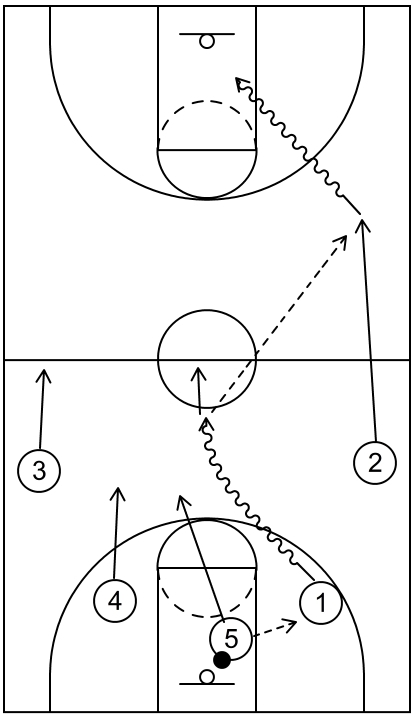
This is a simple example of the backcourt position of 1 throwing a pass to the other backcourt position of 2, particularly from the backcourt area.
It should also be noted that for this diagram, there are no defenders on the court. Nevertheless, let’s imagine that the opposing team just took a jump shot but missed it.
Afterwards, let’s say that 5 gathered the defensive rebound and now has possession of the ball near the basket here in the new offensive team’s backcourt.
Following that, 1 could receive the ball from 5 and begin to dribble towards the frontcourt area.
Also, as that happens, 2 sprints from the backcourt area into the new frontcourt area and then receives the ball from 1 via a pitch ahead pass.
From there, 2 could dribble towards the basket and attempt to score via a layup, dunk, or potential jump shot while the other teammates also sprint into the frontcourt from the backcourt.
Basic information about the backcourt violation
The backcourt violation occurs when an offensive player of a team with control of the basketball on the court changes its state from a valid frontcourt status to an illegal backcourt status.
Penalty for backcourt violation
The main penalty for a backcourt violation is a turnover for the offensive team, particularly to the player who committed the infraction as well as possession of the ball to the opposing team.
Primary factors that generally determine a backcourt violation
First, a team would have to be in control of the ball on the court.
Second, a player of the team in control of the ball has to be the last to touch it within the frontcourt or the last to touch the ball while maintaining frontcourt status.
Third, that same player or another player from the same team has to be the first to touch the ball in the team’s backcourt or be the first to touch the ball with backcourt status.
Primary factors that generally determine backcourt status
A player typically obtains backcourt status when one or both of their feet make contact with their respective backcourt.
In addition to that, if a player with backcourt status is the last to touch the basketball, then it would receive backcourt status as well.
Exceptions for frontcourt status
When an offensive player initially has backcourt status while dribbling the basketball, frontcourt status can only be obtained when that player’s entire body, including both of their feet, as well as the ball are totally in the frontcourt.
What’s more, when a player in their frontcourt grabs hold of the ball in mid-air during unique situations such as a jump ball, inbound pass, or as a defender, the player is allowed to land in the backcourt with one foot or both feet.
No status established after shot attempt exception
If an offensive player attempts a shot at the basket but then that offensive player’s teammate taps the ball into the backcourt, it is typically still possible for any particular offensive player to run into their backcourt from their frontcourt to retrieve the ball.
This is usually legal action because no player or team gained full control of the basketball after the initial shot attempt.
In other words, after a certain offensive player shoots the ball and it happens to get tapped into the backcourt, particularly by another offensive player, frontcourt or backcourt status have not been established because none of the offensive players gained full possession of the basketball.
Therefore, an offensive player would more than likely have the opportunity to run from their frontcourt into their backcourt to retrieve the ball before the defensive team receives it.
Related: 4 Basketball RULES You ALWAYS Get WRONG – Backcourt – YouTube
Related: How do you know when it’s a backcourt violation or not? – Airborne Player – YouTube
Related: Legal play, ball is legally tapped into backcourt – NBA Video Rulebook